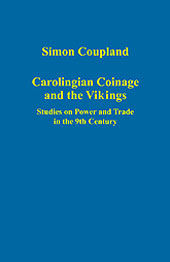
De Re Militari | Book Reviews
Simon Coupland
Carolingian Coinage and the Vikings
Ashgate Variorum Series ISBN 978-0-86078-991-8.

A well written book in two parts. Part one has twelve chapters detailing the make up of the coinage of the Carolingian empire. The second part of three chapter’s deals with the Vikings and their uses of the tribute silver collected.
The first part on Carolingian coins can be challenging for those with little knowledge of numismatics. Mr. Coupland has laid out the information in such away that any scholar can understand the makeup of the early coinage of this period. The use of coinage to trace the flow of power and economy is proven through his data. Quality and purity of coins is traced through the years showing the rise of the rulers and the changes during the reigns by changing effects on the coinage. Regional differences between the kingdoms are also shown by the hoard findings.
The second part of the book deals with the Vikings and their effects in the empire. One chapter deals with the early Vikings warlords. Many are shown to be bought off but many more are shown to convert to Christianity and then join the empire. Brief histories on them are a good read. The ability to play them off against each other is shown to be limited but effective. The chapter on tribute explains many of the effects that the tribute payment had on the county. Its effect is proven in both political and economic conditions. The economic effects are broken down on the church and commoner. The last chapter goes over the lack of coinage and other tribute found in Scandinavia. The small number of coins found from Frankish mints rather than the large number of Middle Eastern coins is explained.
The book does trace the rise and use of power in the eighth and ninth century. Simon Coupland is able to use coinage to explain economic power during the Carolingian period. This is an excellent book in the Variorum series.
Table of Contents
- “Charlemagne’s coinage: ideology and economy 211–229” from Charlemagne: Empire and Society, ed. J. Story. Manchester: Manchester University Press, 2005
- “In palatio nostro: les monnaies palatines de Charlemagne,” from Bulletin de la Société Française de Numismatique 41/7. Paris,1986
- “Money and coinage under Louis the Pious,” from Francia 17/1. Sigmaringen, 1990
- “La chronologie des émissions monétaires de Louis le Pieux (814–840),” from Bulletin de la Société Française de Numismatique 43/7. Paris, 1988
- “The Trier mint 822–840,” from Trierer Zeitschrift 54. Trier, 1991
- “A die-link between coins of Louis the Pious and Lothar I,” from De Beeldenaar 12/6. Utrecht, 1988
- “The coinage of Lothar I (840–855) ,” from Numismatic Chronicle 161. London, 2001
- “The coinages of Pippin I and II of Aquitaine,” from Revue numismatique 31. Paris, 1989
- “The early coinage of Charles the Bald, 840–864,” from Numismatic Chronicle 151. London, 1991
- “L’article XI de l’Edit de Pîtres du 25 juin 864,” fromBulletin de la Société Française de Numismatique 40/9. Paris, 1985
- “Dorestad in the ninth century: the numismatic evidence,” fromJaarboek voor Munt- en Penningkunde 75. Amsterdam, 1988
- “From poachers to gamekeepers: Scandinavian warlords and Carolingian kings,” fromEarly Medieval Europe 7/1. Oxford, 1998
- “Trading places: Quentovic and Dorestad reassessed,” fromEarly Medieval Europe 11/3. Oxford, 2002
- “The Frankish tribute payments to the Vikings and their consequences,” fromFrancia 26/1. Stuttgart, 1999
- “Carolingian coinage and Scandinavian silver,” fromNordisk Numismatisk Årsskrift. Copenhagen, 1985–86
- Addenda and Corrigenda